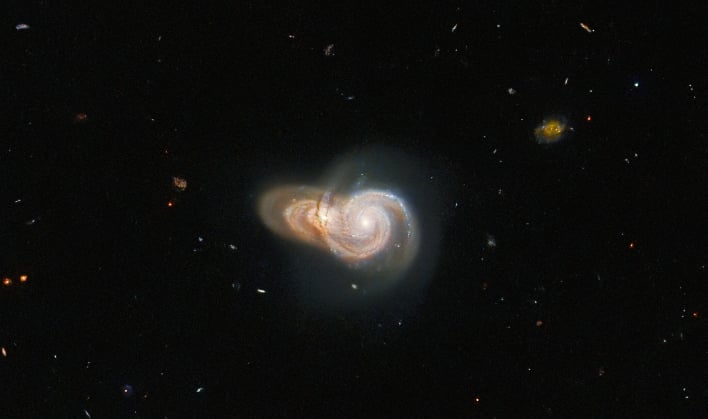Hubble Telescope Snaps Enchanting Shot Of Two Galaxies Intertwined In Cosmic Embrace
The Hubble Space Telescope continues to capture dazzling images from space, as it catches an intimate cosmic dance of two intertwined spiral galaxies. The two galaxies are located more than a billion light-years from Earth.
The European Space Agency (ESA) recently shared an image of two overlapping spiral galaxies, SDSSJ1 15331 and LEDA 2073461. While the image gives the illusion of the two galaxies being intertwined, they are not actually performing a dramatic dance deep in space.
"Despite appearing to collide in this image, the alignment of the two galaxies is likely by chance, the two are not actually interacting," according to a recent post by ESA. "While these two galaxies might simply be ships that pass in the night, Hubble has captured a dazzling array of interacting galaxies in the past."
Throughout Hubble's life span, it has been responsible for capturing many images that have inspired the imagination and helped astronomers and scientists learn more about the great unknown. The image above showcases a pair of galaxies appearing to dance through the night sky, with each being located about 300 million light-years away in the constellation Coma Berenices. The two galaxies have earned the nicknames "The Mice" because of the long tails of stars and gas that emanate from each.
The recent image is just one of many that are highlighted as part of the Galaxy Zoo project. The project was originally established in 2007 and has led to a plethora of citizen science projects which crowdsource galaxy classifications from a selection of hundreds of thousands of volunteers, according to ESA.
Astronomers who coordinate the project applied for Hubble time in order to observe the "most unusual inhabitants of the Galaxy Zoo," however the list of targets was ultimately chosen by a public vote.
The European Space Agency (ESA) recently shared an image of two overlapping spiral galaxies, SDSSJ1 15331 and LEDA 2073461. While the image gives the illusion of the two galaxies being intertwined, they are not actually performing a dramatic dance deep in space.
"Despite appearing to collide in this image, the alignment of the two galaxies is likely by chance, the two are not actually interacting," according to a recent post by ESA. "While these two galaxies might simply be ships that pass in the night, Hubble has captured a dazzling array of interacting galaxies in the past."
Throughout Hubble's life span, it has been responsible for capturing many images that have inspired the imagination and helped astronomers and scientists learn more about the great unknown. The image above showcases a pair of galaxies appearing to dance through the night sky, with each being located about 300 million light-years away in the constellation Coma Berenices. The two galaxies have earned the nicknames "The Mice" because of the long tails of stars and gas that emanate from each.
The recent image is just one of many that are highlighted as part of the Galaxy Zoo project. The project was originally established in 2007 and has led to a plethora of citizen science projects which crowdsource galaxy classifications from a selection of hundreds of thousands of volunteers, according to ESA.
Astronomers who coordinate the project applied for Hubble time in order to observe the "most unusual inhabitants of the Galaxy Zoo," however the list of targets was ultimately chosen by a public vote.



